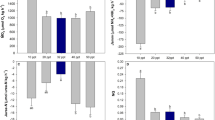Abstract
Two sets of experiments were made to determine ifbis(tri-n-butyl)tin oxide (TBT) [IUPAC: hexabutyldistannoxane] influenced osmotic pressure or chloride ion concentration in hemolymph of adult American oysters,Crassostrea viginica. In the first set, oysters were acclimated to 5, 25, or 40%, then exposed to bis(tri-n-butyl)tin oxide dissolved in seawater (0.5, 1.0 or 2.0 μg/L) for 11 days. Measurements of the total osmotic pressure and chloride ion concentration in hemolymph indicated that mean values of neither was significantly affected under steady state conditions. Oysters exposed to TBT exhibited a higher variation around the mean value for both total osmotic pressure and chloride ion concentration. There was significant mortality of oysters exposed to TBT in 25 and 40, but not in 5%. In a second experiment, adult oysters were acclimated to 25% and simultaneously exposed to the TBT concentrations listed above for 10 days. Then, subgroups of oysters were abruptly moved to 5 or 40% and the time-course of adjustment of hemolymph osmotic pressure and chloride ion concentration was measured. During the first 24 hr, there was little adjustment to 5% in controls or TBT exposed oysters; apparently, they remained closed most or all of the time. In marked contrast, hemolymph of oysters moved to higher salinities rapidly readjusted. Exposure to TBT had a delaying effect on the schedule of the increase in hemolymph osmotic pressure and chloride ion concentration. Results of these experiments show that TBT has an indirect effect on osmotic pressure and chloride ion concentration adjustment in oysters; it does not appear to act strongly as an anionophore to influence anion transfer across epithelia.
Similar content being viewed by others
References
Alzieu C, Thibaud Y, Heral M, Boutier B (1981) Evaluation des risques dus a l'emploi des peintures anti-salissures dans les zones conchylicoles. Ref Trav Inst Peches Marit 44:301–348
Aldridge WN, Street BW (1964) Oxidative phosphorylation. Biochemical effects and properties of trialkyltins. Biochem J 91:287–297
Aldridge WN (1976) The influence of organotin compounds on mitochondrial functions. In: Zuckerman JJ (ed) Organotin Compounds: New Chemistry and Applications. American Chemical Society, Washington, DC, p 186
Anderson RD, Anderson JW (1975) Effects of salinity and selected petroleum hydrocarbons on osmotic and chloride regulation of the American oyster,Crassostrea virginica. Physiol Zool 48:420–430
Bryan GW, Gibbs PE, Hummerstone LG, Burt GR (1986) The decline of the gastropodNucella lapillus around south-west England: Evidence for the effect of tributyltin from anti-fouling paints. J Mar Biol Assoc UK 66:611–640
Castagna M, Chanley P (1973) Salinity tolerance of some marine bivalves from inshore and estuarine environments in Virginia waters on the western mid-Atlantic coast. Malacologia 12:47–96
Hall LW Jr, Lenkevich MJ, Hall WS, Pinkney AE, Bushong SJ (1987) Evaluation of butyltin compounds in Maryland waters of Chesapeake Bay. Mar Pollut Bull 18:78–83
Hand SC, Stickle WB (1977) Effects of tidal fluctuations of salinity on pericardial fluid composition of the American oyster,Crassostrea virginica. Mar Biol 42:259–271
Laughlin RB Jr (1987) Quantitative structure-activity studies of di- and triorganotin compounds. In: Kaiser KLE (ed) QSAR in Environmental Toxicology-II. D Reidel, Dordrect, p 189
Laughlin RB Jr, Guard HE, Coleman WM III (1986) Tributyltinin seawater: Speciation and octanol-water partition coefficient. Environ Sci Technol 20:201–204
Maguire RJ, Carey JH, Hale EJ (1983) Degradation of the tri-n-butyltin species in water. J Agric Food Chem 31:1060–1065
Selwyn MJ (1976) Triorganotin compounds as ionophores and inhibitors of ion translocating ATPase. In: Zuckerman JJ (ed) Organotin Compounds: New Chemistry and Applications. American Chemical Society, Washington, DC, p 204
Unger MA, MacIntyre WG, Greaves J, Huggett RJ (1986) CG determination of butyltins in natural waters by flame photometric detection of hexyl derivatives with mass spectrometric confirmation. Chemosphere 15:461–470
Valkirs AO, Seligman PF, Vafa G, Stang PM, Homer V, Lieberman SH (1985) Speciation of butyltins and methylbu-tyltins in seawater and marine sediments by hydride derivatization and atomic absorption detection. Tech Rep 1087, Naval Oceans Systems Center, San Diego, CA
Valkirs AO, Seligman PF, Stang PM, Homer V, Lieberman SH, Vafa G, Dooley CA (1986) Measurement of butyltin compounds in San Diego Bay. Mar Pollut Bull 17:319–324
Waldock MJ, Thain JE (1983) Shell thickening inCrassostrea gigas: Organotin antifouling or sediment induced? Mar Pollut Bull 14:411–415
Wulf RG, Byington KH (1975) On the structure activity relationship and mechanism of organotin-induced non energy dependent swelling of liver mitochondria. Arch Biochem Biophys 167:176–185
Author information
Authors and Affiliations
Rights and permissions
About this article
Cite this article
Bokman, E., Laughlin, R.B. A study of steady state and kinetic regulation of chloride ion and osmotic pressure in hemolymph of oysters,Crassostrea virginica, exposed to tri-n-butyltin. Arch. Environ. Contam. Toxicol. 18, 832–838 (1989). https://doi.org/10.1007/BF01160297
Received:
Revised:
Issue Date:
DOI: https://doi.org/10.1007/BF01160297




